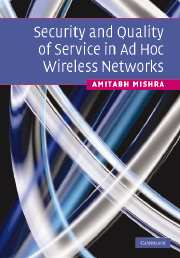3 - Threats and attacks
Published online by Cambridge University Press: 26 February 2010
Summary
Ad hoc networks are vulnerable not only to attacks from outside but also from within. Moreover, these attacks can be active as well as passive. In this chapter, I will discuss the various possible attacks on wireless ad hoc networks; this will then facilitate the discussion about designing the security schemes for such attacks in subsequent chapters. The significance of the various security needs discussed in Chapter 1 now comes to the fore, since any attack essentially disrupts either the operational mechanisms, or the security mechanisms including the security apparatus.
Attack classification
Ad hoc networks are typically subjected to two different levels of attacks. In the first level of attack, the adversary focusses on disrupting the basic mechanisms of the ad hoc network, such as routing, which are essential for proper network operation, and in the second level of attacks, the adversary tries to damage the security mechanisms employed by the network, such as key management schemes or cryptographic algorithms in use. This can be one way of classifying attacks. Alternatively, attacks against ad hoc networks can be classified into two groups in a different way:
Passive attacks which involve only eavesdropping on the data that is being communicated in the network. Examples of passive attacks include covert channels, traffic analysis, sniffing to compromised keys, etc., and
Active attacks which involve specific actions performed by adversaries, for instance, the replication, modification, and deletion of exchanged data among the nodes.
Adversaries attempt to change the behavior of the operational mechanisms in active attacks while they are subtle in their activities in passive attacks.
- Type
- Chapter
- Information
- Publisher: Cambridge University PressPrint publication year: 2008



